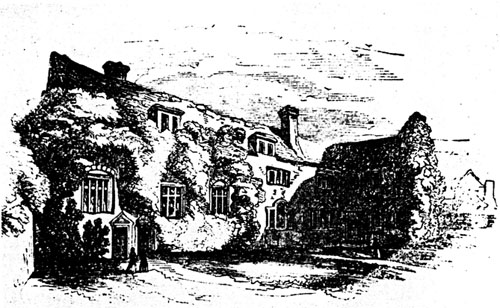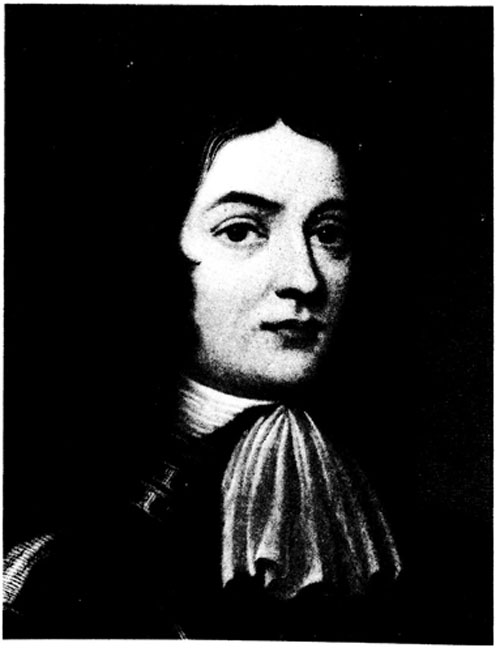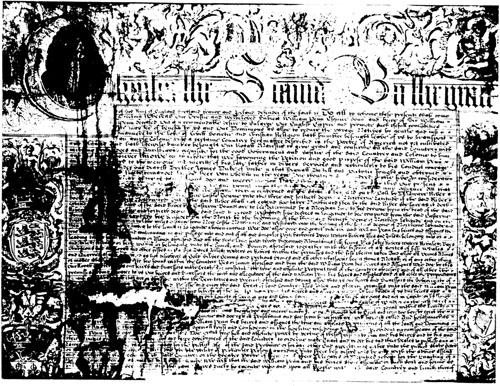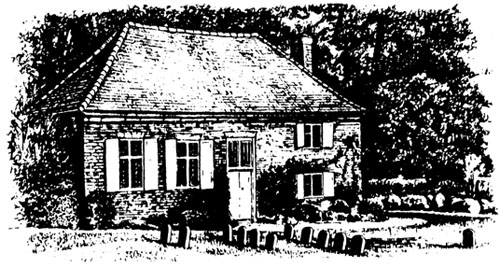|
Home : Quarterly Archives : Volume 19 |
Tredyffrin Easttown Historical Society |
|
Source: October 1981 Volume 19 Number 4, Pages 103–112 The Three Worlds of William Penn TopThe Aristocrat: 1644-1667 On October 14, 1644, William Perm was born in a small, two-room house on the east side of Trinity Square on Tower Hill. His parents had been married in August of 1643 at St. Martin's, Ludgate, in London, and were living within the shadow of the already old and infamous Tower of London. Captain William Penn was a naval officer now in the employ of Parliament, and stationed at Deptford Naval Yard near Greenwich, just three miles down the Thames from London. Margaret Penn, the daughter of a Dutch merchant, John Jasper, and the widow of another Dutchman, Vicasius Vanderschieren, had fled Ireland during the uprisings there and the massacres that followed in 1641. At the time of William Penn's birth, England was in a state of transition. Just three months before, Charles I had lost the decisive battle of the Civil War, the Battle of Marston Moor, to Oliver Cromwell. In fact, throughout his entire life, Penn would be affected by the periods of transition under Cromwell and the Stuart rulers. England had grown — and was still growing — from a small island kingdom under Elizabeth I to a great European and world power. This was the age of Sir Isaac Newton, John Locke, and John Milton. London was not only England's greatest port and the seat of government, but also the center of commerce, art, and culture. In England, one person out of every ten lived in London, while in France only one out of every forty lived in Paris. Seventeenth century London was populated mostly on the north bank of the Thames, from Tower Hill to Whitehall Palace. The Thames River was always crowded with ships and was the great main street; the only bridge over it was the Old Tower Bridge. This was a rich and vital city, but also dirty, crowded, and dangerous. William Penn was baptized in the Anglican faith, at All Hallow's, Barking-by-the-Tower, on nearby Tower Street. The baptism record states, "October 23 William, sonn of William Pen & Margaret his wife of the Tower Liberty". This was the most ancient of the parish churches in the City of London. (Although badly bombed and damaged during the Second World War, it is one of the few remaining landmarks from the life of Penn. The walnut font that was used for his baptism has been owned by, and continually in use, at Christ Church in Philadelphia since 1697.) Immediately after the baptism, Captain Penn went to sea and was away from home for more than four years. Following several victories, he was promoted to the rank of Rear Admiral. In about 1647 Admiral Penn purchased a home in the country in the village of Wanstead in Essex, about ten miles northeast of London. It was also about four miles from Chigwell, where William Penn started his formal education at the Chigwell School. Since Penn was a classical scholar, it can be assumed that it was here that he began his study of Latin and Greek.
Chigwell School where Penn started his formal education During the summer of 1656, when Penn was eleven years old, the family left Wenstead for their estate in Macroom, near Cork, in Ireland. By this time William had a sister, Margaret, aged four, and a baby brother, Richard. Admiral Penn had fallen out of favor with Cromwell, and after a brief imprisonment in the Tower was retired from the navy. The Penns spent four years at Macroom Castle, a thirteenth century fortification of the MacCarthy family. During this time William was educated by private tutors, augmented by his own reading. While in Ireland he had his first contact with the Quaker sect. The Quaker movement had begun in England only a few years before, around 1647, and had not reached Ireland until 1654. An itinerant Quaker preacher named Thomas Loe was in Cork in 1657, and the elder Penn invited him to hold a meeting in his castle. It seems that Loe spoke with such feeling that Admiral Penn was brought to tears. But while this experience was not forgotten, it had no immediate effect on the family. Oliver Cromwell died in 1658. After a period of political instability following his death, the time seemed right for a restoration of the Stuart heir, Charles II, to the throne. The Penns returned to England in March 1660, and the Admiral was named a member of the delegation to bring Charles II to London from Scheveningen, Holland. When Charles II came aboard the ship "Naseby" (named after a battle his father had lost), one of his first acts was to knight Admiral Penn. En route to Dover he also changed the name of the Naseby to the "Royal Charles". Admiral Penn was not only knighted, but was appointed as one of three commissioners of the Royal Navy, under Charles's brother James, the Duke of York, In October of 1660 young William matriculated at Christ Church at Oxford. Oxford University had always supported the Royalist cause, and the king's younger brother, the Duke of Gloucester, had also enrolled at Christ Church; unfortunately he died before the yearfs end and Penn wrote a verse in Latin in his memory. By his second year, however, Penn was having difficulty conforming to the rules of the new Dean, and in March of 1662 he arrived home for good. There is no record of his being expelled, but it can be assumed that he was "sent down for non-comformity". A tour of the continent was considered essential to a gentleman's education in seventeenth and eighteenth century England, and so William was sent to France with the Right Company. It was arranged for him to be presented at the Court of Louis XIV. The Court at that time was usually held at Fontainbleu, since Versailles in 1663 was just a hunting lodge. Louis XIV was 24 years old at the time, and Penn not quite 18 years old. After Paris, William Penn traveled south to the ancient town of Saumur, on the Loire River. Since 1591 Saumur had been a strong Protestant center, and Penn attended L'Academie Protestante de Sauinur in 1663 and 1664.. He boarded with, and studied under, the Protestant theologian Moses Amyraut, one of the most celebrated men of the reformed Church of France during the seventeenth century. Naturally, the thinking of Amyraut was the theological atmosphere of Saumur, and the key to Penn's philosophy, political and spiritual, that was formed at that time. Amyraut taught that the laws of God live in the hearts of man, so every man can know the right and the truth by searching his own conscience. Moses Amyraut died early in 1664, and Penn returned to Paris where he met his friend Robert Spencer, later to become the Earl of Sunderland. Together, they traveled through southern France and northern Italy. There Penn received a letter from his father, urging him to come home as war was about to start between England and Holland. William Penn arrived back in London in August, 1664 a changed person, both on the surface and within. To complete his education, his father decided to enter him in one of the four Inns of Court to study law. He was enrolled at Lincoln's Inn in February of 1665, but his legal studies were soon interrupted by a short voyage on the "Royal Charles" with Sir William, and again by the Great Plague in the summer of 1665. Early in 1666 he left London for his father's new Irish estate at Kinsale and Shanagarry Castle, During the summer he took part in quelling a meeting at Carrickfergus, and had his portrait painted in armor. He returned briefly to London in February of 1667 for his sister Margaret's wedding to Anthony Lowther.
William Penn in armor, at the age of 22 Returning to County Cork, Penn sought out the Quaker Thomas Loe, who was again preaching there. Perm soon fell under his influence and that of another Quaker, Josiah Coale. In September he suffered his first imprisonment for attending a meeting, but his influence in Ireland quickly got him released. TopThe Quaker: 1667-1718 Needless to say, the Admiral was outraged when word reached him from Ireland of his son's imprisonment and Quaker activities. Young William was ordered to come home "with all possible speed" and explain himself. The "all possible speed" took about two months, and to his father's dismay he not only refused to give up his new beliefs, but instead announced that he was going on tour as a missionary to spread the Quaker doctrine. But eventually his father, retired from the navy and in failing health, became reconciled with his son. Durimg the years from 1665 to 1679 Penn became prominent in the Society of Friends and was one of their best spokesmen. In 1667 he spent seven and a half months in prison in the Tower, and while there he wrote the first version of what would be one of his best works, "No Cross, No Crown". In 1670 he was back in prison again, this time in Newgate, for unlawful preaching to an assembly in Grace Church Street. This resulted in the famous trial of Penn and William Mead; today there is a tablet in the Central Criminal Court, the "Old Bailey", which "commemorates the courage and endurance of the jury who refused to give a verdict against them though they [the jury] were locked up without food for two nights and were fined for their verdict of 'Not Guilty', from which developed the right of Juries to give their Verdict according to their Convictions". Thus the sacredness of trial by jury was established for all time. Penn's father died within a week of William's release, and was buried with full military honors in St. Mary's Redcliffe Church, in the port city of Bristol. Under the prevailing law of primogeniture, William Penn inherited all the estates in Ireland and in England. His mother continued to live at the Wenstead property until her death in 1682. On April 4, 1672 Penn married Gulielma Springett (Guli) after four years of courtship. She and her family were dedicated Quakers and quite wealthy. The couple moved to a home in the village of Rickmansworth, where they lived until 1676. Here their first three children were born and died. William's younger brother, Richard, also died here at the age of 18. In 1675 his son Springett was born, and the next year Penn moved his family to Worminghurst in Sussex. Shortly afterwards Penn left on a four months missionary journey to the Low Countries and Germany. It was during this tour that he established contacts which would later result in the Palatine Germans settling in Pennsylvania. Penn continued his preaching and traveling, but was depressed by the continued persecution of the Quakers and by his own failure to secure the election of friends at the polls. It also seemed unlikely that there would be any parliamentary reform of the penal laws. Encouraged by the success of the Jersey colony, it started him to think in terms of an asylum in the new world. TopThe Proprietor: 1681-1718 On June 1, 1680 William Penn formally petitioned the Crown for a grant of territory west of the Delaware River between New York on the north and Maryland on the south. The entire east coast had already been settled in colonies. As C. M. Trevelyan, the British historian, wrote, "Behind that line of coast colonies was founded the most strange settlement of all: Charles II's government, at the moment of the strongest Tory reaction in England, permitted William Penn, the Quaker courtier and organizer, to found Pennsylvania as a refuge for persecuted Friends in the wilderness, where they practised with success the unwanted principles of just dealing with the redskins." Almost as strange was the fact that Charles II granted this petition because of a debt of 16,000 pounds that he owed Admiral Penn, and his brother James, the Duke of York, gladly added the area now known as Delaware so that Penn could secure control of the Delaware River: the Stuarts were not known for ever paying their debts, and especially to a deceased friend's estate! William Penn's old friend from his stay in France, Robert Spencer, now Earl of Sunderland and Secretary of State, supported the petition, and it was granted on March 4, 1681. The colony was called Pennsylvania over Penn's protests. First Purchasers wore recruited by the new Proprietor, and the conditions of sale were drawn up. The Free Society of Traders was formed to promote the economic life of the colony, and Penn sent his first cousin, William Markham, as deputy governor to administer the province. Penn remained in London to work on regulations, sell real estate, and to write a Frame of Government and a set of laws. The original Charter of King Charles II to William Penn established Penn's position not only as the center of political authority, but also as the original landowner who could grant land to the colonists.
First page of the Charter from Charles II granting Perm proprietorship of Pennsylvania This was important to the beginnings of Chester County, and of Easttown Township, which was established in 1704, and Tredyffrin Township, established in 1707. A clause in the original Charter provided, "And Wee toe grant William Penn absolute power to Divide the Country into Townes, Hundreds and Counties, and to incorporate Townes into Borroughs, and Borroughs into Cities." (A "hundred" was an old English administrative division of some counties.) On August 30, 1682 Penn left his wife and three children, Springett, Letitia, and William, Jr., to sail from Deal on the bark "Welcome". Smallpox broke out en route and one-third of the passengers died. Since Penn was immune, he was able to help with the sick. After a long crossing of almost two months, Penn first stepped ashore at New Castle, Delaware, on October 28, 1682. Reembarking, he sailed up the Delaware River to the village of Upland and set foot on Pennsylvania soil. There he changed the name of the settlement from Upland to Chester, and named three counties — Philadelphia, Chester, and Bucks. His first visit to the new colony lasted less than two years, but during that period he traveled about his colony. He established excellent relations with the Indians and was able to learn something of their language. He visited New York, the Jerseys, and also Maryland, where he met with Lord Baltimore to discuss boundary disputes between the two colonies. The Stuarts supported him in his claims against Maryland, but to settle the boundary it was finally necessary for Penn to return to England in 1684. (The problem wasn't settled until the next century, with the Mason-Dixon line.) Before returning to England, Penn also supervised the early laying out of Philadelphia, as well as the building of a house for himself north of the city at Pennsbury. Charles II died in 1685, and his brother, James II, always a friend of the Penns and the Quakers, succeeded him. When James II refused to give up his Catholic religion, however, he was overthrown in 1688 and fled to France. In February 1689 William and Mary, of Holland, accepted the offer of the throne. Because of his friendship with James II, Penn was suspected of treason, and the next few years were difficult ones for him. He suffered constant harrassment, spent two weeks in the Tower, and in October 1692 his proprietorship of Pennsylvania was abolished. On February 23, 1694 his beloved wife of twenty-two years, Guli, died. After the restoration of his Charter in August of that year, Penn began to make plans for another visit to Pennsylvania, and perhaps settling there permanently at Pennsbury. In 1696 he married Hannah Callowhill of Bristol, the daughter of an influential Quaker merchant Thomas Callowhill. Penn was fifty-two years old and Hannah just twenty-eight. Sadness soon followed happiness, however, when Penn's eldest and favorite son Springett died about five weeks after the wedding. Penn was also facing deep financial problems: Pennsylvania had never repaid even a fraction of the costs, and his Irish and English estates needed better management. Before Penn's second — and last — sojourn in America, he spent some time in London. He twice visited with Peter the Great of Russia at the Deptford boat yards, where Peter was learning all he could about building a navy. They communicated in the Dutch language, and Penn answered his many questions about the Quaker faith. Affairs in Pennsylvania had never gone smoothly. Perhaps some of the confusion might have been avoided if Penn had resided there. He finally sailed for his second visit on the "Canterbury" from Cowes with his wife, daughter Letitia, and his secretary, James Logan. They arrived in Philadelphia on December 3, 1699 after a journey of three long months. James Logan, then just twenty-six years of age, proved to be the best appointment Penn ever made. Logan was a man of great administrative ability, and always remained faithful to the proprietary interests. The first child of Penn's second marriage was born in Philadelphia on Second Street in late January of 1700. The baby was named John. The family remained at the new "slate roof house" in the city until April, when they moved to Pennsbury. Penn again traveled north to meet with other colonies to discuss the possibility of a union, and westward to explore the Susquehanna River area, which he was most anxious to develop. As before, his relations with the Indians were most rewarding. He attended many meetings, Courts, and assemblies in the Philadelphia area and in the Lower Counties, as Delaware was then known. His major problems were with the Assembly, which had become divided into factions; with the Quakers, who objected to any military demands; and with the refusal of all colonists to provide him with an income. In 1701 Penn learned from friends in England that his Charter was again in danger as there was a bill before the Parliament to eliminate all colonial proprietorships. Before returning to England with his family in late 1701, Penn signed in haste a "Charter of Privileges", which became Pennsylvania's basic constitution for the next seventy-five years. It was to accompany a "Charter of Property", but Penn refused to sign this. (The original "Charter of Principles" is now in the American Philosophical Society in Philadelphia.) Penn was never again to return to Pennsylvania. In his two visits, fifteen years apart, he had spent less than four years in his colony. The rest of his life would be concerned with personal problems, as well as those dealing with his proprietorship. His business affairs were chaotic. His business manager, Philip Ford, had died in 1702 and his (Ford's) widow demanded payment of debts. Penn even spent about nine months as a Fleet Street Prison debtor in 1709, though he was able to lodge over Old Bailey. A compromise was eventually reached, and it was not necessary for him to sell the colony. His son Billy (William Jr.) was also a constant problem and embarrassment to his father, while his daughter Letitia's husband, William Aubrey, who had demanded a large marriage settlement, was pressing him for payment. To all these worries was added poor health which resulted in several strokes. He tried to sell his colony to the Crown, but could not get the price he needed. Finally, in 1712, he suffered a severe stroke which left him paralyzed and affected his mind. Continuing to work for the Friends as long as he was able, he also spent as much time as he could with Hannah and the children; John, Thomas, Richard and Margaret. In 1710 the Penns had moved to Reescomb, near Twyford in Berkshire. Penn liked the rural area not far from Reading, and it was convenient to both London and Bristol. During the last six years of his life, Hannah cared for him here. He died at Reescomb on July 30, 1718, at the age of 74. As he had requested, he was buried in the graveyard in front of Jordan's Friends Meeting House in Buckinghamshire, near Gulielma and so many of his children. There were several times when his ties with his colony were nearly broken, but in the end Penn left to his widow, Hannah Callowhill Penn, both the property and political interests in Pennsylvania. She continued to watch over the family interests until her death in 1726. By his will, he left to his son John half of Pennsylvania, with the other half divided equally between his sons of his second marriage. Billy inherited the Irish estates. Thus the proprietorship of Pennsylvania remained in the hands of the Penn family until the American Revolution.
Old Jordans Friends Meeting House where William Penn is buried |



